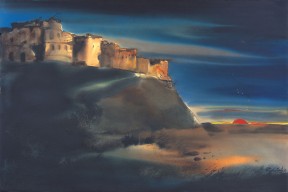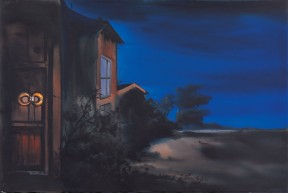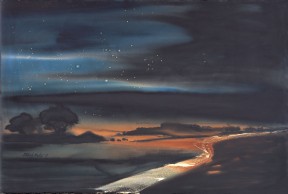Every artist spends a lifetime pursuing immortality through his art. Very few, however, in the face of imminent death, craft a language that is full of hope, courage and dignity. Nobel laureate Rabindranath Tagore, whose 150th birth anniversary the country celebrates this year, was one such artist who penned 15 hauntingly serene poems during the last two years of his life. These untitled poems published posthumously under an anthology titled Shesh Lekha have now inspired a unique artistic collaboration.
Taking a cue from media professional-turned film producer Pritish Nandy’s translation of Tagore’s final 15 verses that have been displayed in handwritten calligraphy, artist Paresh Maity has created 15 corresponding, unique watercolours, embodying the distinctive ambience of Tagore’s last tryst with poetry. Titled Shesh Lekha – The Last Poems of Rabindranath Tagore, the exhibition celebrating the literary genius of the masterful bard is being shown at the National Gallery of Modern Art in New Delhi and is supported by Art Alive gallery.
“The concept of the show hinges on Tagore’s inimitable text and combines the beauty of the written word with the joy that is art,” says Nandy, “What is of particular beauty about these poems, considered by many to be some of the poet’s finest works, is their sense of serene melancholy.”
“There comes the man supreme,
the world is thrilled,
grassblades quiver,
conches resound in the heavens,
gongs of victory sound on earth,
the sacred moment,
announces the great birth.
The forts of the moonless night are ruins today,
on the hilltops dawns echoes
Fear not! Fear not!
hopes of a new life emerge,
hail the new man,
The cosmos reverberates with this cry.” —- Shesh Lekha, Poem 6
Disquietingly simple and elegant, and characteristically spiritual, this collection of verses reiterates the thought that in death there is nothing to fear. Despite the fact that Tagore was ailing at the time he wrote these poems, some were written in Santiniketan and others in Kolkata where he was hospitalised, his writing is an untroubled contemplation of what death can mean, disclosing, through that quiet gesture Tagore’s deep and sensitive understanding of man’s relation to the universe. These short verses contain within themselves a hushed but resonant spirit of triumph that is both heartbreaking and resoundingly inspirational.
“It’s not about death that he writes,” says Nandy, “but about the journey thereafter, a journey that is magical, intriguing and beautiful. It is about dignity in the face of the greatest adversary – death. I first translated these verses in 1973 and have journeyed with them every time I have lost a dear one. These poems give me solace, hope and courage, as they do to anyone who comes in contact with them.”
For Maity, the inspiration was not the obvious pall that stealthily hovers over the source of his inspiration but rather the mystical, surreal aspects of a poet’s invocation to the ultimate unknown.
“Rather than an ode to the ‘end’, to me these texts appear an eager and fervent invitation to a new beginning. In my works, I have attempted to capture this keenness, this sublime essence,” says Maity.
In keeping with his signature style of creating expansive landscapes, Maity communicates the spirituality and intricacy of Tagore’s words while adding his own atmosphere – using sometimes a lonely chair or a dark window, and at times a floating boat or an unknown path – on his canvas to move away from the mundane to the transcendental.
Maity, however, gives titles to his each of his work which are equally evocative as the calligraphic text that is juxtaposed next to it. The Great Unknown – a deep blue watercolour of an unending ocean, Path Forever Clear – a darker paperwork with a long winding path that reaches up to the twinkling stars, Lamp in the Silent Dusk – a richly hued work with blooming flowers, Festival of End – one based on the poem about love and forgiveness, are some such examples.
This dual artistic effort has helped uncover a new Tagore, one hitherto unknown to readers, burdened by thoughts of impending cessation and yet unsurpassable in his calmness, in his eager admiration for and the final, willing submission into the hands of the unknown.
Shesh Lekha – The Last Poems of Rabindranath Tagore is being shown at National Gallery of Modern Art, New Delhi till August 28, 2011. 10 a.m to 5 p.m.
Mondays closed.









Rabindranath Tagore is ever inpiring. My computer table has a photo frame of his with the words, ‘In Tune with Tagore’ I hope the exhibition also comes to Mumbai.